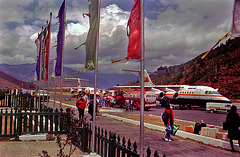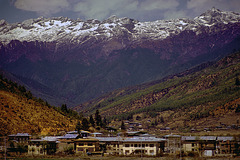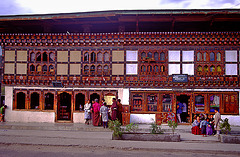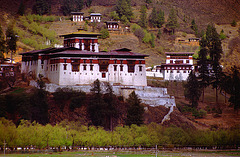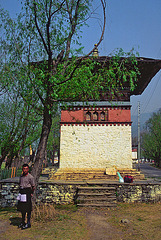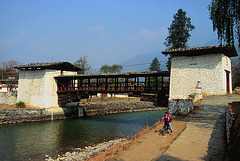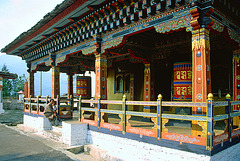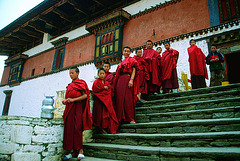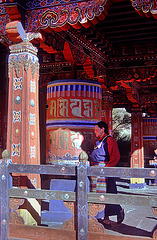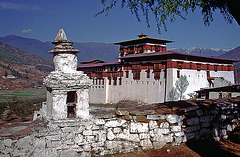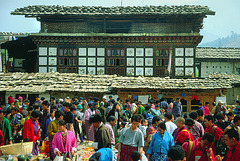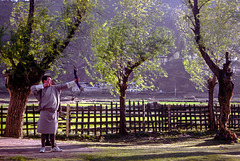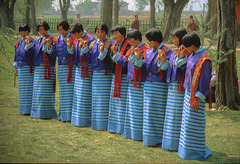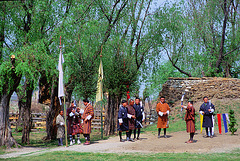
Bhutan, the hidden Himalaya paradise
In this set I post my favorites photos from three visits in Bhutan 1996, 1998 and 2000. On all my trips in Bhutan I value again the kindness of the beautiful people, their honest smiling, the cooperativeness, and the nice educated kids who have much fun when I captured them without asking me for money like in other countries people do it every time. The mentality isn't spoilt from this bad side ef…
(read more)
Airport Paro in Bhutan from Druk Air
| |
|
The airline of Bhutan is called "Druk Air" (the dragon airline). Druk (the dragon) is the national symbol of Bhutan.
http://www.drukair.com.bt/images/Include/National%20Flag.jpg
The National Flag is rectangular and divided diagonally into two parts with a white dragon in the middle. The upper yellow half signifies the country’s secular authority of the King in fruitful action in the affairs of religion and state. The lower saffron orange half signifies the religious practice and spiritual power of Buddhism manifested in the Drukpa Kagyu and Nyingmapa traditions. The Dragon symbolizes the name of the country, locally known as Druk Yul meaning the land of Thunder Dragon and its white colour signifies purity and loyalty of the Bhutanese people.
View into the Dolpo valley
Street scenery in Paro
| |
|
Rinpung Dzong in Paro
| |
|
|
Also known as " fortress of the heap of jewels ", it was built during the time of Shabdrung Ngawang Namgyal in 1646. The approach to the Dzong is through a traditional covered bridge called the Nemi Zam. A walk through the bridge to the Dzong, over a stone inlaid path, offers a good view of the architectural wonder of the Dzong as well as life around it. It is also venue of the Paro Tshechu, held once a year inspiring.
Paro Dzong
| |
|
This was the view from our farm house where we stayed during our visit in Paro. We just stepped over a cabbage field we reached the beautiful alley leading to the Paro Bridge and to the Dzong.
Chorten at the alley to the Paro bridge
| |
|
The Bhutanese word is Chorten, which means “the basis of offering”.
It is a symbol of enlightened mind, (the awakened mind, universal divinity) and the path to its realisation.
The Paro bridge
| |
|
|
The bridge to the Rinpung Dzong crosses the Paro River and got famous in a scenery in Bernardo Bertoluccis master work "Little Buddha".
Prayer wheels at the Ta Dzong monastery
| |
|
|
Many monasteries in Bhutan have large fixed metal or wooden wheels set side by side in a row. Passersby can turn the entire row of wheels simply by sliding their hands over each one. The most commonly used mantra in prayer wheels is Om Mani Padme Hum. This mantra is prayer that invites the compassion of Chenrezig the embodiment of compassion.
Monks in front the Rinpung Dzong in Paro
| |
|
The daily life of the monk is austere, particularly if they are stationed at one of the monasteries located high in the mountains. At these monasteries food is often scarce and must be carried up by the monks or their visitors. The monks are poorly clothed for winter conditions and the monasteries are unheated. The hardship of such a posting is well-recognized; to have a son or brother serving in such a monastery is recognized as very good karma for the family.
Spin the prayer wheel
| |
|
|
Prayer wheels are devices used by religious followers of the Buddha for spreading spiritual blessings and good will. Turning a prayer wheel symbolizes "turning the doctrine," referring to the first teachings of the Buddha, when he set the Wheel of the Law in motion, and accumulates virtues for the well being of mankind. Each turn is the equivalent of reading the prayers within.
The Paro Dzong from northern side
| |
|
|
The Paro Dzong, also called Rinpung Dzong, was started in 1644 on the order of Shabdrung Ngawang Namgyal, the unifier of modern day Bhutan. Unlike most of the other dzongs in Bhutan, it survived the massive 1897 earthquake mostly unscathed, though it was damaged by fire in 1907.
Ta Dzong in Paro
| |
|
Overlooking the Rinpung Dzong it was built in 1951 as a watch tower, unlike the rectangular shape of the Dzongs, Ta Dzong is Round, more like parts of an European castle. From 1967 the Dzong was re-established as the National Museum and holds fascinating collection of arts, relics, religious thangkha, and many others.
At the Paro market
Bhutanese man playing archery
| |
|
Archery tournaments are also very popular, but many of the participants and spectators are older Bhutanese. Archery has been practised in Bhutan for centuries, and is the only game, along with taekwondo, in which Bhutan has a chance of winning some medals at the next Olympic Games.
More description about archery I gave to my further posted pictures.
Dancing women in their traditional Kira
| |
|
The kira is the national dress for women in Bhutan. It is an ankle-length dress known as the kira which is clipped at the shoulder and tied at the waist. An accompaniment to the kira is a long-sleeved blouse which is worn underneath. Social status and class is determined by the texture, bright colours, and decorations embellishing the garments
Monks watching the women dancing performance
| |
|
Monks from everywhere in Bhutan come to the Tsechu festival and enjoy watching the performances.
Bhutanese men get to meet for archery
| |
|
Isn't it strange that the master of archery (2002) was a Bhutanese woman who pushed through herself the mens archery society? Women enjoy the same skills and rights in Bhutan.
Kyichu Lhakhang Monastery
| |
|
The origin of Kyichu Lhakhang dates back to the seventh century, it is one of the oldest and most sacred shrines of Bhutan (the other is Jambey Lhakhang in Bumthang). Kyichu Lhakhang is composed of twin temples, the first temple was built by Buddhist Tibetan King, Songtsen Gampo in the 7th century and in 1968, H.M. Ashi Kessang, the Queen Mother of Bhutan, arranged for a second temple to be built alongside the first one, in same style.
Jump to top
RSS feed- Latest items - Subscribe to the latest items added to this album
- ipernity © 2007-2024
- Help & Contact
|
Club news
|
About ipernity
|
History |
ipernity Club & Prices |
Guide of good conduct
Donate | Group guidelines | Privacy policy | Terms of use | Statutes | In memoria -
Facebook
Twitter

